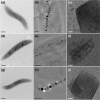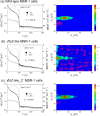Deletion of the ftsZ-like gene results in the production of superparamagnetic magnetite magnetosomes in Magnetospirillum gryphiswaldense
- PMID: 20023033
- PMCID: PMC2812952
- DOI: 10.1128/JB.01292-09
Deletion of the ftsZ-like gene results in the production of superparamagnetic magnetite magnetosomes in Magnetospirillum gryphiswaldense
Abstract
Magnetotactic bacteria (MTB) synthesize unique organelles termed "magnetosomes," which are membrane-enclosed structures containing crystals of magnetite or greigite. Magnetosomes form a chain around MamK cytoskeletal filaments and provide the basis for the ability of MTB to navigate along geomagnetic field lines in order to find optimal microaerobic habitats. Genomes of species of the MTB genus Magnetospirillum, in addition to a gene encoding the tubulin-like FtsZ protein (involved in cell division), contain a second gene termed "ftsZ-like," whose function is unknown. In the present study, we found that the ftsZ-like gene of Magnetospirillum gryphiswaldense strain MSR-1 belongs to a 4.9-kb mamXY polycistronic transcription unit. We then purified the recombinant FtsZ-like protein to homogeneity. The FtsZ-like protein efficiently hydrolyzed ATP and GTP, with ATPase and GTPase activity levels of 2.17 and 5.56 mumol phosphorus per mol protein per min, respectively. The FtsZ-like protein underwent GTP-dependent polymerization into long filamentous bundles in vitro. To determine the role of the ftsZ-like gene, we constructed a ftsZ-like mutant (DeltaftsZ-like mutant) and its complementation strain (DeltaftsZ-like_C strain). Growth of DeltaftsZ-like cells was similar to that of the wild type, indicating that the DeltaftsZ-like gene is not involved in cell division. Transmission electron microscopic observations indicated that the DeltaftsZ-like cells, in comparison to wild-type cells, produced smaller magnetosomes, with poorly defined morphology and irregular alignment, including large gaps. Magnetic analyses showed that DeltaftsZ-like produced mainly superparamagnetic (SP) magnetite particles, whereas wild-type and DeltaftsZ-like_C cells produced mainly single-domain (SD) particles. Our findings suggest that the FtsZ-like protein is required for synthesis of SD particles and magnetosomes in M. gryphiswaldense.
Figures





Similar articles
-
MamX encoded by the mamXY operon is involved in control of magnetosome maturation in Magnetospirillum gryphiswaldense MSR-1.BMC Microbiol. 2013 Sep 11;13:203. doi: 10.1186/1471-2180-13-203. BMC Microbiol. 2013. PMID: 24020498 Free PMC article.
-
Work Patterns of MamXY Proteins during Magnetosome Formation in Magnetospirillum gryphiswaldense MSR-1.Appl Environ Microbiol. 2019 Jan 9;85(2):e02394-18. doi: 10.1128/AEM.02394-18. Print 2019 Jan 15. Appl Environ Microbiol. 2019. PMID: 30367002 Free PMC article.
-
Loss of the actin-like protein MamK has pleiotropic effects on magnetosome formation and chain assembly in Magnetospirillum gryphiswaldense.Mol Microbiol. 2010 Jul 1;77(1):208-24. doi: 10.1111/j.1365-2958.2010.07202.x. Epub 2010 May 12. Mol Microbiol. 2010. PMID: 20487281
-
Magnetosome biogenesis in magnetotactic bacteria.Nat Rev Microbiol. 2016 Sep 13;14(10):621-37. doi: 10.1038/nrmicro.2016.99. Nat Rev Microbiol. 2016. PMID: 27620945 Review.
-
The bacterial magnetosome: a unique prokaryotic organelle.J Mol Microbiol Biotechnol. 2013;23(1-2):63-80. doi: 10.1159/000346543. Epub 2013 Apr 18. J Mol Microbiol Biotechnol. 2013. PMID: 23615196 Review.
Cited by
-
Development of cellular magnetic dipoles in magnetotactic bacteria.Biophys J. 2010 Aug 9;99(4):1268-73. doi: 10.1016/j.bpj.2010.05.034. Biophys J. 2010. PMID: 20713012 Free PMC article.
-
The magnetosome model: insights into the mechanisms of bacterial biomineralization.Front Microbiol. 2013 Nov 26;4:352. doi: 10.3389/fmicb.2013.00352. Front Microbiol. 2013. PMID: 24324464 Free PMC article. Review.
-
A Compass To Boost Navigation: Cell Biology of Bacterial Magnetotaxis.J Bacteriol. 2020 Oct 8;202(21):e00398-20. doi: 10.1128/JB.00398-20. Print 2020 Oct 8. J Bacteriol. 2020. PMID: 32817094 Free PMC article. Review.
-
Magnetotactic bacteria as potential sources of bioproducts.Mar Drugs. 2015 Jan 16;13(1):389-430. doi: 10.3390/md13010389. Mar Drugs. 2015. PMID: 25603340 Free PMC article. Review.
-
Iron response regulator protein IrrB in Magnetospirillum gryphiswaldense MSR-1 helps control the iron/oxygen balance, oxidative stress tolerance, and magnetosome formation.Appl Environ Microbiol. 2015 Dec;81(23):8044-53. doi: 10.1128/AEM.02585-15. Epub 2015 Sep 18. Appl Environ Microbiol. 2015. PMID: 26386052 Free PMC article.
References
-
- Altschul, S. F., W. Gish, W. Miller, E. W. Myers, and D. J. Lipman. 1990. Basic local alignment search tool. J. Mol. Biol. 215:403-410. - PubMed
-
- Arakaki, A., J. Webb, and T. Matsunaga. 2003. A novel protein tightly bound to bacterial magnetic particles in Magnetospirillum magneticum strain AMB-1. J. Biol. Chem. 278:8745-8750. - PubMed
-
- Bazylinski, D. A., and R. B. Frankel. 2004. Magnetosome formation in prokaryotes. Nat. Rev. Microbiol. 2:217-230. - PubMed
-
- Blakemore, R. P. 1975. Magnetotactic bacteria. Science 190:377-379. - PubMed
-
- Blakemore, R. P. 1982. Magnetotactic bacteria. Annu. Rev. Microbiol. 36:217-238. - PubMed
Publication types
MeSH terms
Substances
Grants and funding
LinkOut - more resources
Full Text Sources
Molecular Biology Databases

